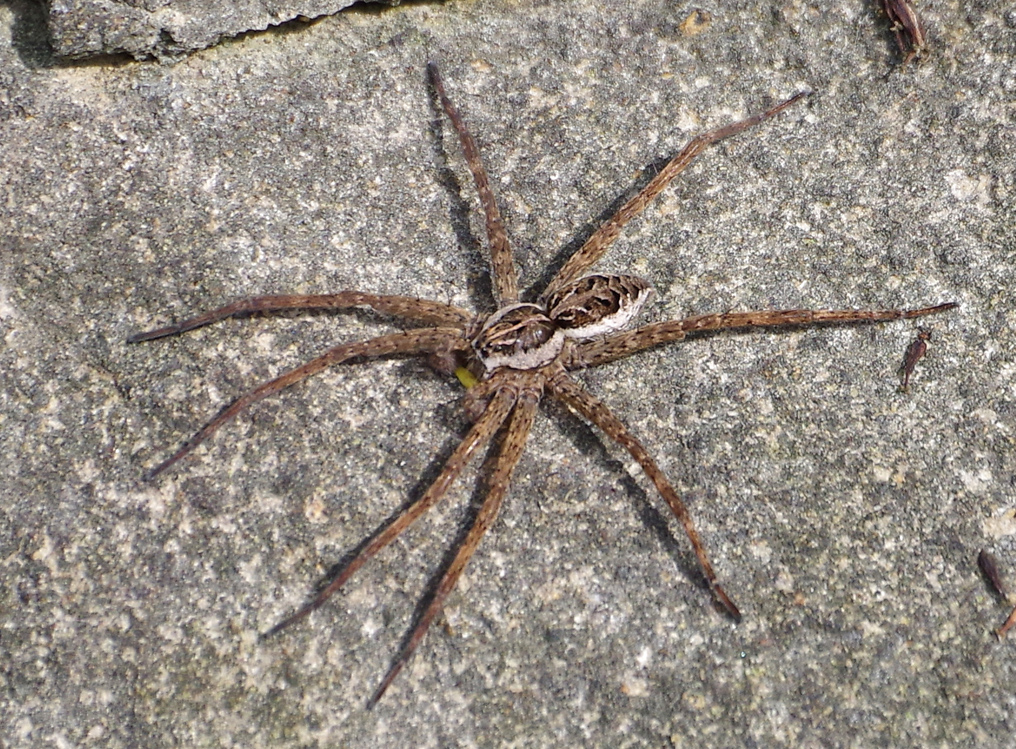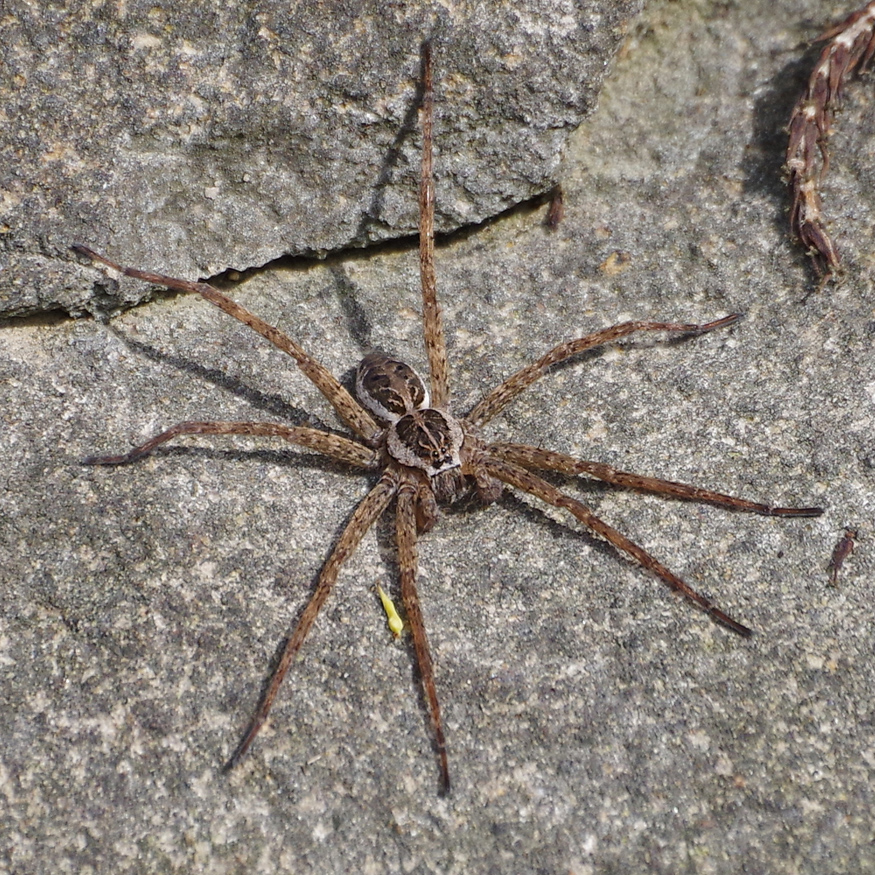
Striped Fishing Spider
When the BugLady was on Riveredge’s excellent floating pier in the Milwaukee River last spring, she looked over and saw two, spectacular Striped fishing spiders on rocks above the waterline.
Fishing spiders are in the Nursery web spider family Pisauridae and in the genus Dolomedes, (the fishing spiders), so called because even though most of their diet is made up of aquatic invertebrates, these large spiders are hefty enough to catch tadpoles and small fish (as one website said, “They’re big enough to saddle up and ride”). Because they’re found near water, they’re often called “dock spiders.”
They are marvelously adapted to locomote across – and under – the water. These are pretty hairy spiders, and their “hydrophobic” (water-repellant) hairs allow them to dive under the surface film (to pursue or to escape) and to swim without really getting wet, and the air bubbles trapped in those hairs provide them with enough oxygen to stay under for about 30 minutes. They can not only stand https://bugguide.net/node/view/311363/bgimage, “row,” and run across the water, they can glide across its surface using their raised front legs as a sail.
Different spider families have unique eye arrangements – here are the eight eyes of a typical nursery web spider https://bugguide.net/node/view/1151143/bgimage. Weber, in Spiders of the North Woods, says that their eyes glow green at night in the light of a flashlight.
They catch their prey by ambushing and/or chasing it, not by making trap webs, but they do produce silk. Fishing spiders spin silken lines to keep from being carried downstream, and females lay a trail of pheromone laced web across the water’s surface for males to follow. They use silk to construct egg sacs, which they carry in their jaws, and later suspend it in a nursery web (wolf spiders also carry an egg sac around, too, but at the rear, attached to their spinnerets). And, of course, newly-emerged spiderlings disperse by parachuting away from their siblings https://uwm.edu/field-station/spider-flight-rerun/.

STRIPED FISHING SPIDERS (Dolomedes scriptus) (scriptus means “written”) are also called Writing fishing spiders because the markings on their abdomen look like a broad letter ”W” https://bugguide.net/node/view/122617/bgimage. They are found around wetlands in southern Canada, much of the eastern US, and a few Great Plains states, and they prefer fast-flowing streams and rivers.
Some have a white stripe around the sides of their cephalothorax and abdomen, and some don’t https://bugguide.net/node/view/1219135/bgimage. There are several other species of large fishing spiders in the area that Striped fishing spiders can be mistaken for and, as always, BugFan Mike reminds us that the most accurate way to ID spiders is by aiming a hand lens at its naughty-bits (he may have used more technical terminology). Males are smaller and have a slimmer abdomen than females https://bugguide.net/node/view/1225089/bgimage. The books say that this species grows to a 2 ½” leg-span, but the BugLady is pretty sure that the two females she saw exceeded that.
Their normal prey is mostly insects that they find on or in the water. Striped fishing spiders typically sit on the shore or on floating leaves with their three front pairs of legs extended onto the water. They can sense the ripples caused by insects that are swimming on the surface film (like water striders), or are trapped on it (like moths that dipped too close), or are swimming below it, and they rush out to apprehend them. They also eat dragonflies, various fly and mosquito larvae that come to the surface to breathe, and other fishing spiders. The BugLady found an article about a Striped fishing spider that was seen eating a small crayfish. By the time it was discovered, the spider had anchored the crayfish with silk and had eaten most of its abdomen. Researchers speculated that the spider had grabbed the crayfish from behind, avoiding its pincers as it injected its cocktail of toxins (their bites are not a problem for people unless you happen to be sensitive to them).
Great predators though they are, they are also prey. Striped fishing spiders are eaten by fish, frogs, birds, and even large dragonfly naiads. And there’s a spider wasp (wasp family Pompilidae) that specializes in the Dolomedes spiders! Anoplius depressipes https://bugguide.net/node/view/84121/bgimage, which at first glance resembles some solitary wasps in the family Sphecidae, collects fishing spiders and caches them in nest cells for her young to eat when they hatch. Let the Missouri Department of Conservation “Discover Nature” Field Guide tell it: “In the early 1900s, entomologists — including Missourian Phil Rau — noted an unusual sight: a wasp flying very low over a stream, dragging a spider across the surface film like a wind skier. It remained a mystery species among insect geeks until entomologist and nature writer Howard Ensign Evans identified it as Anoplius depressipes, one of the so-called blue-black spider wasps. It turns out this species hunts fishing spiders (Dolomedes spp.) and possesses specialized flattened front feet that are fringed with hairs, which allow it to walk on water, just like its prey. When transporting a spider, this species grasps the spider with its middle or hind legs, faces forward, then extends its forelegs and uses them like water skis while it propels itself and its prey across the top of the water, beating its wings, like an air boat in the Everglades https://bugguide.net/node/view/2039627/bgimage. This spider wasp sometimes dives down into water to chase its prey, since water spiders often swim underwater when frightened. Not surprisingly, it nests in burrows in stream banks.”
Curious thing – bugguide.net’s collection of pictures of any one species may contain three pictures or 300-plus. There were only 13 shots of Anoplius depressipes, but seven of them had captured the wasp on water with prey https://bugguide.net/node/view/262134/bgimage!
Much has been written about female spiders dining on their inamoratos (it’s called sexual cannibalism); it’s not inevitable, but it does provide a nutritional boost for egg-making. Male fishing spiders woo cautiously, and because she is already tuned in to the vibrations that insects make on the surface film, his signals must be different (his rhythm is slower than that of a trapped and frantic insect). If she misreads his signals, or he misreads hers, or she’s just plain hungry, or if she gets the message, sizes him up, and he is found wanting, it doesn’t bode well for him.
She may lay as many as 1,000 eggs, spinning a two-layered, waterproof sac around them. She guards her offspring by carrying them with her jaws for a week or so until she senses that they’re hatching inside the sac https://bugguide.net/node/view/1572784/bgimage https://bugguide.net/node/view/277075/bgimage (she doesn’t eat for the duration – her mouth is already full). She installs the sac in a three-dimensional jumble of silk in some leaves or twigs https://bugguide.net/node/view/1304813/bgimage and hangs around for another week or so https://bugguide.net/node/view/886889/bgimage to protect her spiderlings https://bugguide.net/node/view/886890/bgimage, https://bugguide.net/node/view/1025906/bgimage. The partially-grown spiderlings will overwinter in a sheltered spot.
Kate Redmond, The BugLady
Bug of the Week archives:
http://uwm.edu/field-station/category/bug-of-the-week/
